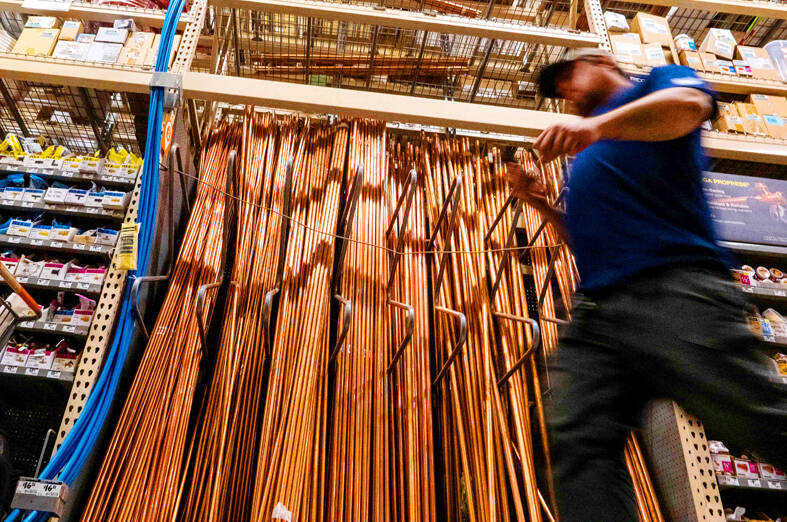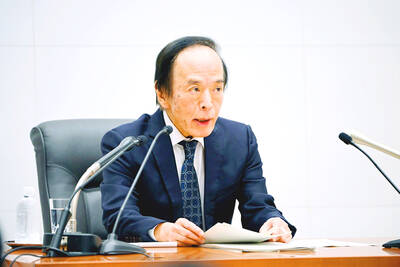US President Donald Trump’s plans to impose 50 percent tariffs on copper imports are set to include the kinds of materials used for power grids, the military and data centers.
Plans involve including semi-finished products, said people familiar with the matter who asked not to be named as discussions are private.
That comes as few details of Trump’s plans for copper tariffs have been revealed so far.

Photo: AFP
The tariff measures have not yet been formalized and they could change.
It has been widely expected that refined copper would be tariffed, but it was unclear what would happen with semi-finished products — a category that includes wires, sheets, tubes and plates. Including semi-fabricated goods would ramp up the impact of the levies.
The levies, which Trump said would come into effect on Aug. 1, would have far-reaching impacts on the US. The move is expected to raise costs across a swath of the US economy due to the myriad of industries and applications reliant on the metal. Copper is used in everything from consumer electronics and automobiles to construction and the military.
Trump is pursuing the tariffs as part of his effort to bolster the US’ copper supply chain, which encompasses mining, refining and processing, recycling and making semi-finished goods and end products.
The biggest category imported by the US is refined copper, which has a metal content of more than 99.993 percent. The US imported 908,000 tonnes last year, which were consumed by fabricators to make rods, cables and alloys.
North America’s biggest fabricator is Southwire Co, which supplies wires for US military installations and naval vessels. Southwire did not immediately respond to a request for comment.
The Copper Development Association describes copper semi-products as the key link in the US military-industrial supply chain in its March 31 submission to the US Department of Commerce for this year’s copper investigation under Section 232 of the Trade Expansion Act.
The industry group presented its comments on behalf of 90 percent of US copper semi-producers.
Domestic copper production is not enough for the US — forcing the country to source a significant amount of semi-finished copper from abroad.
An estimated 800,000 tonnes of copper and copper alloy semi-fabricated products were imported last year, on top of refined copper, according to MM Markets, a consultancy working with US fabricators and recyclers.
MM Markets cofounder Krisztina Kalman expects the 50 percent tariff to extend to semi-products for security reasons.
Any disturbance in foreign supply of copper and semi-finished products could expose the US to significant issues in delivering electricity, she said.
Imposing tariffs on semi-finished copper could also bring disruption to fabricators, since wire rod mills rely on primary imports and levies would drive up their costs.
“The local fabricators will not be able to produce 800,000 tonnes more semi-products with current capacity, and it could take up to seven years to install new capacity,” Kalman said.

Taiwan Semiconductor Manufacturing Co (TSMC, 台積電) last week recorded an increase in the number of shareholders to the highest in almost eight months, despite its share price falling 3.38 percent from the previous week, Taiwan Stock Exchange data released on Saturday showed. As of Friday, TSMC had 1.88 million shareholders, the most since the week of April 25 and an increase of 31,870 from the previous week, the data showed. The number of shareholders jumped despite a drop of NT$50 (US$1.59), or 3.38 percent, in TSMC’s share price from a week earlier to NT$1,430, as investors took profits from their earlier gains

In a high-security Shenzhen laboratory, Chinese scientists have built what Washington has spent years trying to prevent: a prototype of a machine capable of producing the cutting-edge semiconductor chips that power artificial intelligence (AI), smartphones and weapons central to Western military dominance, Reuters has learned. Completed early this year and undergoing testing, the prototype fills nearly an entire factory floor. It was built by a team of former engineers from Dutch semiconductor giant ASML who reverse-engineered the company’s extreme ultraviolet lithography (EUV) machines, according to two people with knowledge of the project. EUV machines sit at the heart of a technological Cold

TAIWAN VALUE CHAIN: Foxtron is to fully own Luxgen following the transaction and it plans to launch a new electric model, the Foxtron Bria, in Taiwan next year Yulon Motor Co (裕隆汽車) yesterday said that its board of directors approved the disposal of its electric vehicle (EV) unit, Luxgen Motor Co (納智捷汽車), to Foxtron Vehicle Technologies Co (鴻華先進) for NT$787.6 million (US$24.98 million). Foxtron, a half-half joint venture between Yulon affiliate Hua-Chuang Automobile Information Technical Center Co (華創車電) and Hon Hai Precision Industry Co (鴻海精密), expects to wrap up the deal in the first quarter of next year. Foxtron would fully own Luxgen following the transaction, including five car distributing companies, outlets and all employees. The deal is subject to the approval of the Fair Trade Commission, Foxtron said. “Foxtron will be

INFLATION CONSIDERATION: The BOJ governor said that it would ‘keep making appropriate decisions’ and would adjust depending on the economy and prices The Bank of Japan (BOJ) yesterday raised its benchmark interest rate to the highest in 30 years and said more increases are in the pipeline if conditions allow, in a sign of growing conviction that it can attain the stable inflation target it has pursued for more than a decade. Bank of Japan Governor Kazuo Ueda’s policy board increased the rate by 0.2 percentage points to 0.75 percent, in a unanimous decision, the bank said in a statement. The central bank cited the rising likelihood of its economic outlook being realized. The rate change was expected by all 50 economists surveyed by Bloomberg. The